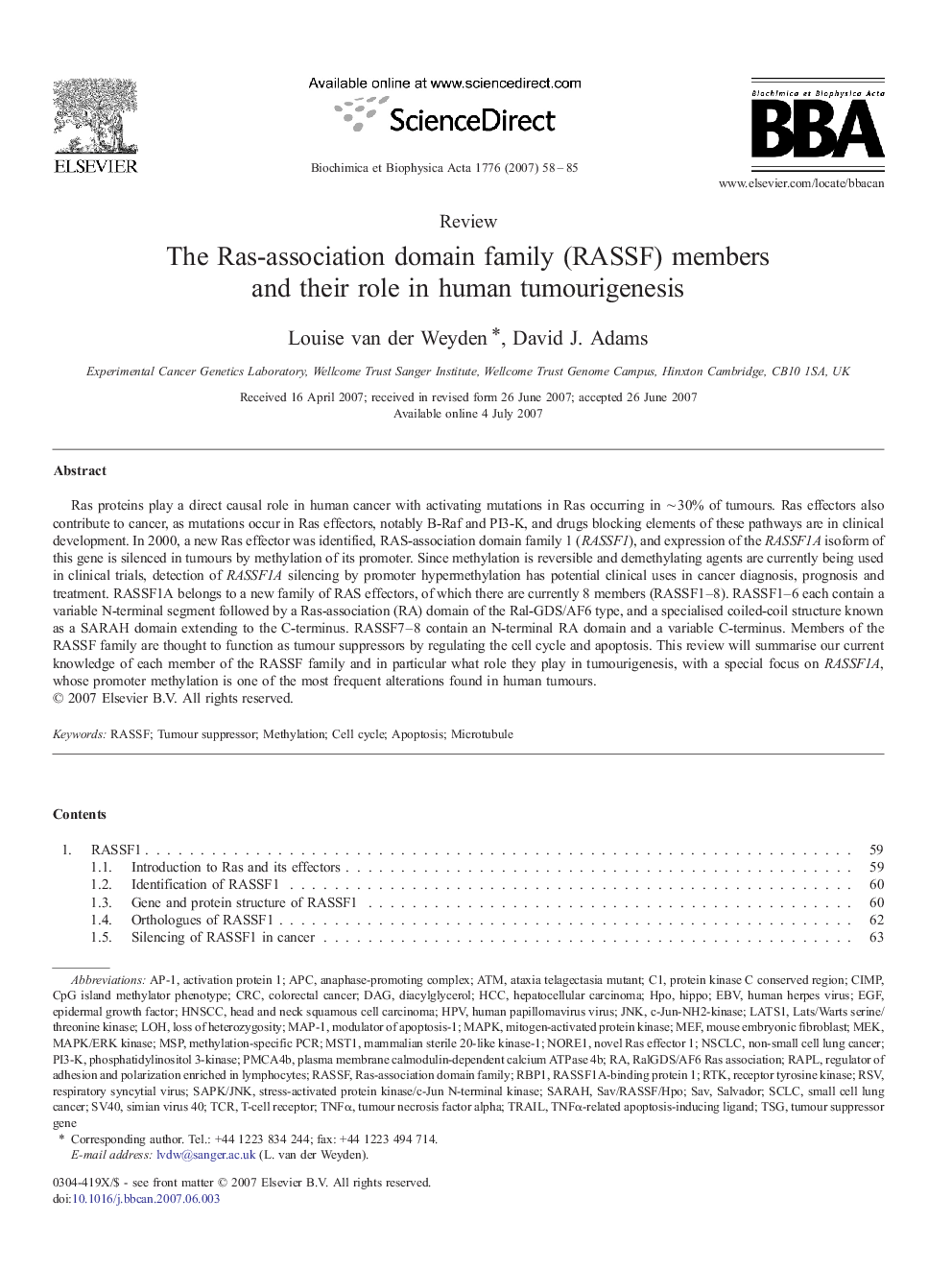| کد مقاله | کد نشریه | سال انتشار | مقاله انگلیسی | نسخه تمام متن |
|---|---|---|---|---|
| 10895642 | 1083113 | 2007 | 28 صفحه PDF | دانلود رایگان |
عنوان انگلیسی مقاله ISI
The Ras-association domain family (RASSF) members and their role in human tumourigenesis
دانلود مقاله + سفارش ترجمه
دانلود مقاله ISI انگلیسی
رایگان برای ایرانیان
کلمات کلیدی
CIMPAPCAP-1PI3-KMST1RSVSV40TSGRTKMSPHNSCCSAVRBP1Lats1RAPLMAP-1NORE1Novel Ras Effector 1JnkTCrMEFTNFαEGFHCC - HCCHpo - HPOMAPK - MAPKMAPK/ERK kinase - MAPK / ERK kinaseMethylation-specific PCR - PCR اختصاصی متیلاتCpG island methylator phenotype - phenotype methylparate جزیره CpGSAPK/JNK - SAPK / JNKloss of heterozygosity - از دست دادن هتروزیگوتیسمhippo - اسب آبیstress-activated protein kinase/c-Jun N-terminal kinase - استنتاج پروتئین کیناز / c-Jun N-terminal kinaseEBV - اپشتین بار ویروسSCLC - بگذارندtumour necrosis factor alpha - تومور نکروز عامل آلفاApoptosis - خزان یاختهایATM - خودپردازdiacylglycerol - دیسیل گلیسیرینRASSF - راسفDAG - روزMicrotubule - ریزلوله یا میکروتوبولSARAH - ساراSalvador - سالوادورColorectal cancer - سرطان روده بزرگNSCLC - سرطان ریوی غیر سلول کوچکSmall cell lung cancer - سرطان سلول کوچک ریهNon-small cell lung cancer - سرطان غیر سلول کوچک ریهTumour suppressor - سرکوب کننده تومورepidermal growth factor - عامل رشد اپیدرمیPhosphatidylinositol 3-kinase - فسفاتیدیلینواستیل 3-کینازTRAIL - قطارLOH - لوهانMethylation - متیلاسیونMEK - مجاهدین خلقmouse embryonic fibroblast - موش فیبروبلاست جنینیRespiratory syncytial virus - ویروس سنسیتیال تنفسیSimian virus 40 - ویروس سیمانی 40human herpes virus - ویروس هرپس انسانیHPV - ویروس پایپلوم انسانیactivation protein 1 - پروتئین فعال سازی 1mitogen-activated protein kinase - پروتئین کیناز فعال با mitogenanaphase-promoting complex - پیچیده ترویج آنافازCell cycle - چرخه سلولیTumour suppressor gene - ژن سرکوب کننده تومورHead and neck squamous cell carcinoma - کارسینوم سلول سنگفرشی سر و گردنHepatocellular carcinoma - کارسینوم هپاتوسلولار(کارسینوم سلولهای استخوانی)CRC - کد افزونگی دورهای Receptor Tyrosine Kinase - گیرنده تیروزین کینازT-cell receptor - گیرنده لنفوسیت T
موضوعات مرتبط
علوم زیستی و بیوفناوری
بیوشیمی، ژنتیک و زیست شناسی مولکولی
تحقیقات سرطان
پیش نمایش صفحه اول مقاله

چکیده انگلیسی
Ras proteins play a direct causal role in human cancer with activating mutations in Ras occurring in â¼Â 30% of tumours. Ras effectors also contribute to cancer, as mutations occur in Ras effectors, notably B-Raf and PI3-K, and drugs blocking elements of these pathways are in clinical development. In 2000, a new Ras effector was identified, RAS-association domain family 1 (RASSF1), and expression of the RASSF1A isoform of this gene is silenced in tumours by methylation of its promoter. Since methylation is reversible and demethylating agents are currently being used in clinical trials, detection of RASSF1A silencing by promoter hypermethylation has potential clinical uses in cancer diagnosis, prognosis and treatment. RASSF1A belongs to a new family of RAS effectors, of which there are currently 8 members (RASSF1-8). RASSF1-6 each contain a variable N-terminal segment followed by a Ras-association (RA) domain of the Ral-GDS/AF6 type, and a specialised coiled-coil structure known as a SARAH domain extending to the C-terminus. RASSF7-8 contain an N-terminal RA domain and a variable C-terminus. Members of the RASSF family are thought to function as tumour suppressors by regulating the cell cycle and apoptosis. This review will summarise our current knowledge of each member of the RASSF family and in particular what role they play in tumourigenesis, with a special focus on RASSF1A, whose promoter methylation is one of the most frequent alterations found in human tumours.
ناشر
Database: Elsevier - ScienceDirect (ساینس دایرکت)
Journal: Biochimica et Biophysica Acta (BBA) - Reviews on Cancer - Volume 1776, Issue 1, September 2007, Pages 58-85
Journal: Biochimica et Biophysica Acta (BBA) - Reviews on Cancer - Volume 1776, Issue 1, September 2007, Pages 58-85
نویسندگان
Louise van der Weyden, David J. Adams,